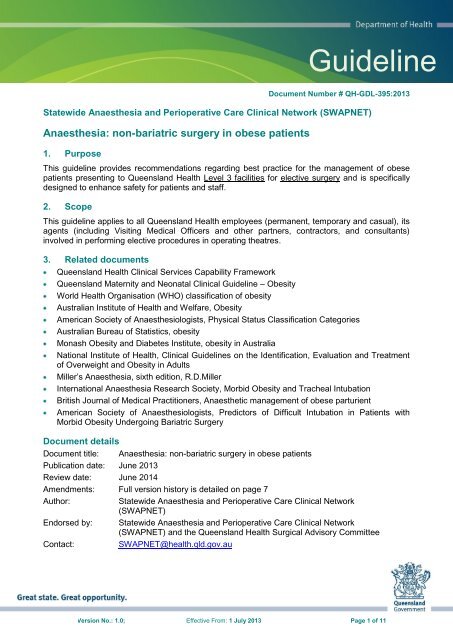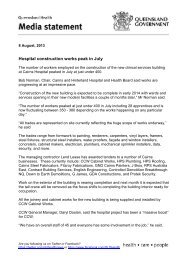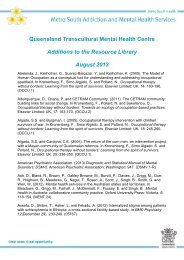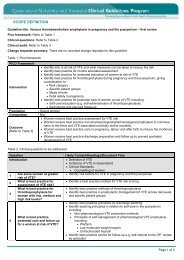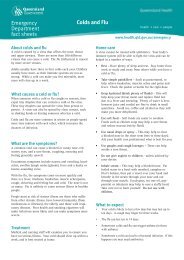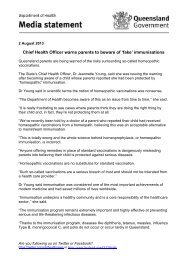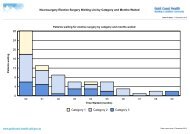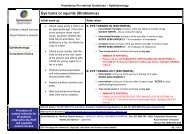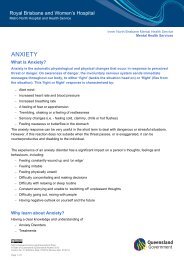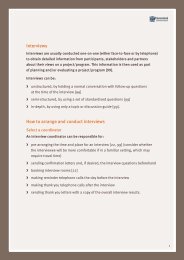Anaesthesia: non-bariatric surgery in obese patients guideline
Anaesthesia: non-bariatric surgery in obese patients guideline
Anaesthesia: non-bariatric surgery in obese patients guideline
Create successful ePaper yourself
Turn your PDF publications into a flip-book with our unique Google optimized e-Paper software.
Guidel<strong>in</strong>e<br />
[Optional head<strong>in</strong>g here. Change font size to suit]<br />
Document Number # QH-GDL-395:2013<br />
Statewide <strong>Anaesthesia</strong> and Perioperative Care Cl<strong>in</strong>ical Network (SWAPNET)<br />
<strong>Anaesthesia</strong>: <strong>non</strong>-<strong>bariatric</strong> <strong>surgery</strong> <strong>in</strong> <strong>obese</strong> <strong>patients</strong><br />
1. Purpose<br />
This guidel<strong>in</strong>e provides recommendations regard<strong>in</strong>g best practice for the management of <strong>obese</strong><br />
<strong>patients</strong> present<strong>in</strong>g to Queensland Health Level 3 facilities for elective <strong>surgery</strong> and is specifically<br />
designed to enhance safety for <strong>patients</strong> and staff.<br />
2. Scope<br />
This guidel<strong>in</strong>e applies to all Queensland Health employees (permanent, temporary and casual), its<br />
agents (<strong>in</strong>clud<strong>in</strong>g Visit<strong>in</strong>g Medical Officers and other partners, contractors, and consultants)<br />
<strong>in</strong>volved <strong>in</strong> perform<strong>in</strong>g elective procedures <strong>in</strong> operat<strong>in</strong>g theatres.<br />
3. Related documents<br />
Queensland Health Cl<strong>in</strong>ical Services Capability Framework<br />
Queensland Maternity and Neonatal Cl<strong>in</strong>ical Guidel<strong>in</strong>e – Obesity<br />
World Health Organisation (WHO) classification of obesity<br />
Australian Institute of Health and Welfare, Obesity<br />
American Society of Anaesthesiologists, Physical Status Classification Categories<br />
Australian Bureau of Statistics, obesity<br />
Monash Obesity and Diabetes Institute, obesity <strong>in</strong> Australia<br />
National Institute of Health, Cl<strong>in</strong>ical Guidel<strong>in</strong>es on the Identification, Evaluation and Treatment<br />
of Overweight and Obesity <strong>in</strong> Adults<br />
Miller’s <strong>Anaesthesia</strong>, sixth edition, R.D.Miller<br />
International <strong>Anaesthesia</strong> Research Society, Morbid Obesity and Tracheal Intubation<br />
British Journal of Medical Practitioners, Anaesthetic management of <strong>obese</strong> parturient<br />
American Society of Anaesthesiologists, Predictors of Difficult Intubation <strong>in</strong> Patients with<br />
Morbid Obesity Undergo<strong>in</strong>g Bariatric Surgery<br />
Document details<br />
Document title: <strong>Anaesthesia</strong>: <strong>non</strong>-<strong>bariatric</strong> <strong>surgery</strong> <strong>in</strong> <strong>obese</strong> <strong>patients</strong><br />
Publication date: June 2013<br />
Review date: June 2014<br />
Amendments: Full version history is detailed on page 7<br />
Author:<br />
Statewide <strong>Anaesthesia</strong> and Perioperative Care Cl<strong>in</strong>ical Network<br />
(SWAPNET)<br />
Endorsed by: Statewide <strong>Anaesthesia</strong> and Perioperative Care Cl<strong>in</strong>ical Network<br />
(SWAPNET) and the Queensland Health Surgical Advisory Committee<br />
Contact:<br />
SWAPNET@health.qld.gov.au<br />
Version No.: ; Effective From: Page 1 of 11<br />
Version No.: ; Effective From: Page 1 of 11<br />
Version No.: 1.0; Effective From: 1 July 2013 Page 1 of 11
SWAPNET Guidel<strong>in</strong>e: <strong>Anaesthesia</strong> – Non-<strong>bariatric</strong> Surgery <strong>in</strong> Obese Patients<br />
Disclaimer:<br />
These guidel<strong>in</strong>es have been prepared to promote and facilitate standardisation and<br />
consistency of practice, us<strong>in</strong>g a multidiscipl<strong>in</strong>ary approach. Information <strong>in</strong> this guidel<strong>in</strong>e is<br />
current at time of publication.<br />
Queensland Health does not accept liability to any person for loss or damage <strong>in</strong>curred as<br />
a result of reliance upon the material conta<strong>in</strong>ed <strong>in</strong> this guidel<strong>in</strong>e.<br />
Cl<strong>in</strong>ical material offered <strong>in</strong> this guidel<strong>in</strong>e does not replace or remove cl<strong>in</strong>ical judgement or<br />
the professional care and duty necessary for each specific patient case.<br />
Cl<strong>in</strong>ical care carried out <strong>in</strong> accordance with this guidel<strong>in</strong>e should be provided with<strong>in</strong> the<br />
context of locally available resources and expertise.<br />
This Guidel<strong>in</strong>e does not address all elements of standard practice and assumes that<br />
<strong>in</strong>dividual cl<strong>in</strong>icians are responsible to:<br />
• Discuss care with consumers <strong>in</strong> an environment that is culturally appropriate and<br />
which enables respectful confidential discussion. This <strong>in</strong>cludes the use of <strong>in</strong>terpreter<br />
services where necessary<br />
• Advise consumers of their choice and ensure <strong>in</strong>formed consent is obta<strong>in</strong>ed<br />
• Provide care with<strong>in</strong> scope of practice, meet all legislative requirements and ma<strong>in</strong>ta<strong>in</strong><br />
standards of professional conduct<br />
• Apply standard precautions and additional precautions as necessary, when deliver<strong>in</strong>g<br />
care.<br />
• Document all care <strong>in</strong> accordance with mandatory and local requirements.<br />
© State of Queensland (Queensland Health) 2013<br />
This work is licensed under a Creative Commons Attribution Non-Commercial No Derivatives 3.0 Australia licence. In essence, you are free to copy and<br />
communicate the work <strong>in</strong> its current form for <strong>non</strong>-commercial purposes, as long as you attribute Queensland Maternity and Neonatal Cl<strong>in</strong>ical Guidel<strong>in</strong>es<br />
Program, Queensland Health and abide by the licence terms. You may not alter or adapt the work <strong>in</strong> any way. To view a copy of this licence, visit<br />
http://creativecommons.org/licenses/by-nc-nd/3.0/au/deed.en<br />
For further <strong>in</strong>formation contact the Statewiide <strong>Anaesthesia</strong> and Perioperative Care Cl<strong>in</strong>ical Network (SWAPNET), PO Box 128, RBWH Post Office, Herston<br />
Qld 4029, email SWAPNET@health.qld.gov.au, phone (07) 3131 6968. For permissions beyond the scope of this licence contact: Intellectual Property<br />
Officer, Queensland Health, GPO Box 48, Brisbane Qld 4001, email ip_officer@health.qld.gov.au, phone (07) 3234 1479.<br />
Version No.: 1.0: Effective From: 1 July 2013 Page 2 of 11
SWAPNET Guidel<strong>in</strong>e: <strong>Anaesthesia</strong> – Non-<strong>bariatric</strong> Surgery <strong>in</strong> Obese Patients<br />
4. Guidel<strong>in</strong>e for <strong>Anaesthesia</strong>: <strong>non</strong>-<strong>bariatric</strong> <strong>surgery</strong> <strong>in</strong> <strong>obese</strong> <strong>patients</strong><br />
4.1 BMI Classification<br />
Body Mass Index (BMI) is a simple <strong>in</strong>dex of weight for height that is commonly used to<br />
classify underweight, overweight and obesity <strong>in</strong> adults. It is def<strong>in</strong>ed as the weight <strong>in</strong><br />
kilograms divided by the square of the height <strong>in</strong> metres (kg/m 2 ).<br />
The World Health Organisation (WHO) <strong>in</strong>ternational classification of adult underweight,<br />
overweight and obesity accord<strong>in</strong>g to BMI is as follows:<br />
Classification BMI(kg/m 2 )<br />
Pr<strong>in</strong>cipal cut-off po<strong>in</strong>ts<br />
Additional cut-off po<strong>in</strong>ts<br />
Underweight
SWAPNET Guidel<strong>in</strong>e: <strong>Anaesthesia</strong> – Non-<strong>bariatric</strong> Surgery <strong>in</strong> Obese Patients<br />
4.3 Guidel<strong>in</strong>es for anaesthesia for elective <strong>surgery</strong><br />
The follow<strong>in</strong>g <strong>in</strong>formation has been developed to provide assistance for consideration<br />
of requirements for safe anaesthetic practice <strong>in</strong> this population group present<strong>in</strong>g for<br />
elective <strong>surgery</strong>.<br />
CSCF Level 3 and below facilities (GP anaesthetists, high dependency unit and Bilevel<br />
positive airway pressure (BiPAP) available) are able to provide treatment to<br />
<strong>patients</strong> under the follow<strong>in</strong>g criteria:<br />
- BMI < 30 Surgical complexity IV for ASA 2-3<br />
- BMI < 35 Surgical complexity III for ASA 2-3<br />
- BMI 36-40 Surgical complexity III for ASA 2<br />
- BMI > 40 Surgical complexity II<br />
Patients that fall outside the above criteria should be discussed between the surgical<br />
and anaesthetic teams and consideration be given to transferr<strong>in</strong>g them to the closest<br />
hospital with an appropriate CSCF level for the patient BMI.<br />
Informed consent for procedures should <strong>in</strong>clude a risk discussion of complications of<br />
obesity.<br />
CSCF Level 4 and 5 (specialist anaesthetists, subspecialty surgeons, access to<br />
<strong>in</strong>tensive care unit, access to coronary care unit and BiPAP available) are able to<br />
provide treatment to <strong>patients</strong> under the follow<strong>in</strong>g criteria:<br />
- BMI < 40 Surgical complexity IV for ASA 3-4<br />
- BMI < 50 Surgical complexity III for ASA 3-4<br />
- BMI < 60 Surgical complexity III for ASA 2 (<strong>in</strong> discussion) eg. sp<strong>in</strong>al for dilatation<br />
and curettage of the uterus (D&C)<br />
- BMI > 60 Surgical complexity II<br />
Patients that fall outside the above criteria should be discussed between the surgical<br />
and anaesthetic teams and consideration be given to transferr<strong>in</strong>g them to the closest<br />
hospital with an appropriate CSCF level for the patient BMI if the facility does not have<br />
the necessary resources to manage them effectively or if complications are predictable.<br />
If a decision is made by the multidiscipl<strong>in</strong>ary team and the patient to proceed with the<br />
anaesthesia and procedure, <strong>in</strong>formed consent should <strong>in</strong>clude a comprehensive<br />
discussion with the patient about the risks and complications associated with obesity<br />
and acknowledgment <strong>in</strong> writ<strong>in</strong>g from the patient that they fully understand the risks and<br />
complications.<br />
(Refer to CSCF Surgical Complexity Criteria, attachment 2)<br />
4.4 Emergency Surgery<br />
Obese <strong>patients</strong> that fall outside the elective CSCF criteria will present for emergency<br />
<strong>surgery</strong>. If a patient cannot be transferred due to urgency or logistics (eg. no <strong>bariatric</strong><br />
Version No.: 1.0: Effective From: 1 July 2013 Page 4 of 11
SWAPNET Guidel<strong>in</strong>e: <strong>Anaesthesia</strong> – Non-<strong>bariatric</strong> Surgery <strong>in</strong> Obese Patients<br />
ambulance or flight available) effective communication between medical, surgical,<br />
nurs<strong>in</strong>g and allied health staff is required.<br />
4.5 Recommended requirements<br />
4.5.1 Preoperative<br />
4.5.1.1 Patient<br />
Usual work up plus Neck circumference greater than 50cm and mallampati 3,<br />
<strong>in</strong>dicative of difficult airway, preparation for an awake fibre optic<br />
<strong>in</strong>tubation, second anaesthetist and adjuncts available.<br />
Cardiovascular<br />
Disease<br />
Pulmonary<br />
Hypertension, control, ischaemic heart disease, congestive heart<br />
failure. Consider preoperative echocardiogram right atrial<br />
pressure<br />
Asthma, obstructive sleep apnoea, consider preoperative arterial<br />
blood gas if BMI > 50, polycythemia implies susta<strong>in</strong>ed hypoxemia.<br />
Gastro<strong>in</strong>test<strong>in</strong>al Reflux (88% of <strong>obese</strong> <strong>patients</strong> have a gastric pH of < 2.5 and 85%<br />
have a gastric volume > 25ml), diabetic control<br />
4.5.1.2 Equipment<br />
- Table and transfer devices appropriate for weight (eg arm<br />
boards to expand table)<br />
- “Hover” mattress slide sheets<br />
- Arterial l<strong>in</strong>e for blood pressure monitor<strong>in</strong>g, and use of<br />
ultrasound for IV and regional placement<br />
- In anticipation of obstructed airway, “ramp<strong>in</strong>g” equipment,<br />
difficult airway trolley <strong>in</strong> the room<br />
- Early de-saturation, 10l/m<strong>in</strong> nasal prong oxygen<br />
supplementation or pressure support ventilation with tight mask<br />
to provide CPAP pre-oxygenation<br />
- Deep ve<strong>in</strong> thrombosis protection devices.<br />
4.5.1.3 Staff<strong>in</strong>g<br />
- Extra personnel for transfers, position<strong>in</strong>g and retraction as<br />
required.<br />
4.5.2 Intraoperative<br />
- Anticipation of early de-saturation/reflux as above, ramp<strong>in</strong>g and 10l/m<strong>in</strong><br />
nasal prong oxygen supplementation<br />
- Patient protection – padd<strong>in</strong>g, beware of constrict<strong>in</strong>g cloth<strong>in</strong>g<br />
- Prevention of temperature loss<br />
- DVT prophylaxis<br />
Version No.: 1.0: Effective From: 1 July 2013 Page 5 of 11
SWAPNET Guidel<strong>in</strong>e: <strong>Anaesthesia</strong> – Non-<strong>bariatric</strong> Surgery <strong>in</strong> Obese Patients<br />
- Discussion with surgeon, <strong>in</strong>cision site<br />
- Regional techniques/decreased opioid.<br />
4.5.3 Postoperative<br />
- Position, head up tilt 30degrees<br />
- Cont<strong>in</strong>ued monitor<strong>in</strong>g<br />
- Careful analgesic regime and follow up, acute pa<strong>in</strong> service, consider<br />
regional anaesthesia techniques and <strong>non</strong> sedative analgesics<br />
- Early BiPAP or CPAP, supplementary oxygen 72-96 hours for abdom<strong>in</strong>al<br />
<strong>in</strong>cisions<br />
- Early consultation with allied health for requirements for mobilization,<br />
appropriate beds and chairs<br />
- Fluids, nutrition, prote<strong>in</strong> supplementation.<br />
(For more comprehensive <strong>in</strong>formation refer to related policy or<br />
documentation).<br />
4.6 Transferr<strong>in</strong>g <strong>patients</strong> to another facility – considerations for decision mak<strong>in</strong>g<br />
Decision mak<strong>in</strong>g around whether to transfer a patient to another facility for treatment is<br />
<strong>in</strong> some cases quite clear and relatively easy to decide eg. 74 year old, BMI > 45,<br />
poorly controlled diabetes, obstructive jaundice, and unstable ang<strong>in</strong>a need<strong>in</strong>g an ERCP<br />
or cholecystectomy. However, some cases are more complex and not clear and <strong>in</strong><br />
these <strong>in</strong>stances, it is important for all issues to be considered.<br />
If the situation is <strong>in</strong> your op<strong>in</strong>ion marg<strong>in</strong>al and all other members of the team assess<br />
that to proceed is appropriate, consideration should be given to clearly document<strong>in</strong>g<br />
your concerns. Discuss your concerns with the patient and ask them to acknowledge<br />
your concerns and advice by writ<strong>in</strong>g them <strong>in</strong> their patient health record, particularly with<br />
respect to the care that may not be immediately available <strong>in</strong> your facility should<br />
complications develop eg. angiography for an acute coronary syndrome <strong>in</strong> the postoperative<br />
period.<br />
In terms of ischaemic heart disease and obesity where <strong>patients</strong> may have a risk of a<br />
major cardiac event, 0.5% to 12%, dependent on their co-morbid risk factors <strong>in</strong> the<br />
perioperative period (Lee’s Index). Consideration of <strong>in</strong>volvement of the patient and their<br />
relatives, with their documented acknowledgement of the possible complications is<br />
recommended. It will be of great assistance should the patient be one of the 1% of<br />
<strong>patients</strong> who suffer a complication.<br />
Accord<strong>in</strong>g to the REASON study, <strong>patients</strong> over the age of 70 years undergo<strong>in</strong>g <strong>surgery</strong><br />
with an expected <strong>in</strong>patient stay of 2 or more days had a 30 day mortality rate <strong>in</strong> excess<br />
of 5%, 10% required admission to an <strong>in</strong>tensive care unit and 20% had complications.<br />
Patient factors correlated better with the outcome than did the type of <strong>surgery</strong><br />
(<strong>Anaesthesia</strong>, 2010, 65, pages 1022–1030). However, it is also important to consider<br />
that removal of elderly <strong>patients</strong> from familiar faces and family support <strong>in</strong> itself <strong>in</strong>creases<br />
mortality.<br />
Version No.: 1.0: Effective From: 1 July 2013 Page 6 of 11
SWAPNET Guidel<strong>in</strong>e: <strong>Anaesthesia</strong> – Non-<strong>bariatric</strong> Surgery <strong>in</strong> Obese Patients<br />
Consideration of all of the above factors and the <strong>in</strong>volvement of all team members <strong>in</strong><br />
the decision mak<strong>in</strong>g process (<strong>in</strong>clud<strong>in</strong>g consultation with relevant representatives from<br />
the facility to which the patient is be<strong>in</strong>g transferred if required) and the family is<br />
recommended.<br />
5. Review<br />
This guidel<strong>in</strong>e is due for review on: 30 June 2014<br />
Date of Last Review: N/A<br />
Supersedes: New document<br />
6. Bus<strong>in</strong>ess Area Contact<br />
Cl<strong>in</strong>ical Access and Redesign Unit, Health Systems Innovation Branch<br />
7. Guidel<strong>in</strong>e revision and approval history<br />
Version Modified by Amendments authorised by Approved by<br />
No.<br />
v0.01 Annette Turley,<br />
SWAPNET Steer<strong>in</strong>g<br />
Committee member<br />
SWAPNET Steer<strong>in</strong>g Committee Peter Moran and Helen<br />
Werder, Co-Cl<strong>in</strong>ical Chairs,<br />
SWAPNET<br />
v0.02 Karen Hamilton SWAPNET Steer<strong>in</strong>g Committee As above<br />
v0.03 Karen Hamilton Follow<strong>in</strong>g consultation with As above<br />
Statewide Directors of<br />
<strong>Anaesthesia</strong><br />
v0.04 Karen Hamilton Endorsed by SWAPNET As Above<br />
Steer<strong>in</strong>g Committee on 1/2/2013<br />
v0.05 Karen Hamilton Endorsed by the Surgical As above<br />
Advisory Committee on<br />
4/2/2013<br />
v0.06 Karen Hamilton SWAPNET Steer<strong>in</strong>g Committee As above<br />
after statewide consultation<br />
V1.0 Karen Hamilton No amendments Michael Cleary, Deputy<br />
Director-General, Health<br />
Service and Cl<strong>in</strong>ical<br />
Innovation Division<br />
8. Approval and Implementation<br />
Policy Custodian:<br />
Chief Allied Health Officer<br />
Approv<strong>in</strong>g Officer:<br />
Dr Michael Cleary, Deputy Director-General, Health Service and Cl<strong>in</strong>ical Innovation<br />
Approval date: 19 June 2013<br />
Effective from: 01 July 2013<br />
Version No.: 1.0: Effective From: 1 July 2013 Page 7 of 11
SWAPNET Guidel<strong>in</strong>e: <strong>Anaesthesia</strong> – Non-<strong>bariatric</strong> Surgery <strong>in</strong> Obese Patients<br />
ATTACHMENT 1<br />
Background <strong>in</strong>formation<br />
Accord<strong>in</strong>g to the Australian Bureau of Statistics 2008 data, the proportion of adults (aged 18 or<br />
over) classified as <strong>obese</strong> or overweight <strong>in</strong>creased from 56% <strong>in</strong> 1995 to 61% <strong>in</strong> 2007-08 (men<br />
<strong>in</strong>creased from 64% to 68% and women <strong>in</strong>creased from 49% to 55%) result<strong>in</strong>g <strong>in</strong> health system<br />
costs, productivity decl<strong>in</strong>es and carers costs <strong>in</strong> 2008 totall<strong>in</strong>g approximately $58 billion mak<strong>in</strong>g it<br />
the s<strong>in</strong>gle biggest threat to public health <strong>in</strong> Australia.<br />
Obesity affects all age groups and contributes to numerous and varied co-morbid conditions.<br />
Complications can occur <strong>in</strong> many organ systems, rang<strong>in</strong>g from cardiovascular to respiratory to<br />
orthopaedic and even ophthalmologic. Overweight and obesity are known risk factors for heart<br />
disease, diabetes, hypertension, gallbladder disease, osteoarthritis, sleep apnoea and other<br />
breath<strong>in</strong>g problems, and some cancers (uter<strong>in</strong>e, breast, colorectal, kidney, and gallbladder). In<br />
addition, obesity is associated with pregnancy complications, high blood cholesterol, menstrual<br />
irregularities, hirsutism (excessive hair growth), stress <strong>in</strong>cont<strong>in</strong>ence, psychological disorders, and<br />
<strong>in</strong>creased surgical risk.<br />
Obesity-related co-morbidity requires specific <strong>in</strong>tervention and management on the part of the<br />
anaesthetist and modifies perioperative and post-operative risk. Obese <strong>patients</strong> present<strong>in</strong>g for<br />
anaesthesia and <strong>surgery</strong> are likely to suffer a number of obesity related co-morbidities. The<br />
majority of these are related not only to the severity of overweight or obesity, but also to their<br />
duration. Most require <strong>in</strong>dependent consideration and management. The effects of these comorbidities<br />
may be more severe and less predictable than <strong>in</strong> <strong>non</strong>-<strong>obese</strong> <strong>in</strong>dividuals. Appropriate<br />
<strong>in</strong>vestigation and control of obesity related conditions are best handled by a multidiscipl<strong>in</strong>ary team<br />
approach.<br />
Morbid obesity is associated with <strong>in</strong>creased morbidity and mortality; reduces life expectancy by up<br />
to 10 years; <strong>in</strong>creases occupational health and safety risks for staff deliver<strong>in</strong>g health care services<br />
and presents a significant risk factor for anaesthesia and <strong>surgery</strong>. It complicates airway<br />
management and <strong>in</strong>creases the risk of gastric reflux and aspiration. Fat acts as a reservoir for<br />
anaesthetic agents mak<strong>in</strong>g it difficult to accurately titrate doses. Cardiovascular co-morbidities,<br />
diabetes and deranged respiratory mechanics further <strong>in</strong>crease the risk.<br />
Queensland status<br />
In Queensland, obesity is a grow<strong>in</strong>g health issue. In 2011, 57.4% of the adult population weighed<br />
more than is recommended for good health mak<strong>in</strong>g obesity the largest s<strong>in</strong>gle contribut<strong>in</strong>g risk<br />
factor for premature death and disability overtak<strong>in</strong>g tobacco.<br />
Patients with BMIs greater than 40, 50 and 60 are present<strong>in</strong>g to Queensland Health facilities for<br />
elective <strong>surgery</strong>. These <strong>patients</strong> pose an <strong>in</strong>creased burden on the health system as they require<br />
additional pre and post-operative care and additional resources <strong>in</strong> terms of staff and equipment.<br />
Cl<strong>in</strong>ical Service Capability Framework<br />
The Cl<strong>in</strong>ical Services Capability Framework (CSCF) has been developed to provide a standard set<br />
of m<strong>in</strong>imum capability criteria for service delivery and plann<strong>in</strong>g <strong>in</strong> Queensland. The capability of<br />
Version No.: 1.0: Effective From: 1 July 2013 Page 8 of 11
SWAPNET Guidel<strong>in</strong>e: <strong>Anaesthesia</strong> – Non-<strong>bariatric</strong> Surgery <strong>in</strong> Obese Patients<br />
health services is recognised as an essential element <strong>in</strong> the provision of safe and quality patient<br />
care.<br />
The framework outl<strong>in</strong>es the m<strong>in</strong>imum service requirements, staff<strong>in</strong>g, support services and risk<br />
considerations for both public and private health services to ensure safe and appropriately<br />
supported cl<strong>in</strong>ical service delivery (<strong>in</strong>clud<strong>in</strong>g anaesthesia and <strong>surgery</strong>), but does not provide any<br />
direction <strong>in</strong> relation to <strong>obese</strong> <strong>patients</strong>.<br />
The CSCF Framework and the surgical complexity matrix have been referenced to guide the<br />
development of these guidel<strong>in</strong>es and are to be used <strong>in</strong> conjunction with the Queensland Maternity<br />
and Neonatal Cl<strong>in</strong>ical Guidel<strong>in</strong>e - Obesity.<br />
References and l<strong>in</strong>ks:<br />
1. http://www.abs.gov.au/ausstats/abs@.nsf/Lookup/by%20Subject/1370.0~2010~Chapter~Obesi<br />
ty%20(4.1.6.6.3)<br />
2. http://www.aihw.gov.au/obesity-health-priority-area/<br />
3. http://www.modi.monash.edu.au/obesity-facts-figures/obesity-<strong>in</strong>-australia/<br />
4. http://www.nhlbi.nih.gov/guidel<strong>in</strong>es/obesity/ob_gdlns.pdf<br />
5. Cl<strong>in</strong>ical Service Capability Framework, Queensland Health 2011<br />
6. Miller’s <strong>Anaesthesia</strong>, sixth edition, R.D.Miller<br />
7. http://www.anesthesia-analgesia.org/content/94/3/732.full<br />
8. http://www.bjmp.org/content/anaestheic-management-<strong>obese</strong>-parturient<br />
9. http://www.asaabstracts.com/strands/asaabstracts/abstract.htm;jsessionid=70511C2B9C6C80<br />
D74E07F81034A3D6EE?year=2007&<strong>in</strong>dex=4&absnum=768<br />
10. Queensland Maternity and Neonatal Cl<strong>in</strong>ical Guidel<strong>in</strong>e - Obesity<br />
11. World Health Organisation BMI classification<br />
Version No.: 1.0: Effective From: 1 July 2013 Page 9 of 11
SWAPNET Guidel<strong>in</strong>e: <strong>Anaesthesia</strong> – Non-<strong>bariatric</strong> Surgery <strong>in</strong> Obese Patients<br />
CSCF Surgical Complexity Criteria<br />
ATTACHMENT 2<br />
Surgical complexity I<br />
Surgical complexity I (SCI) (eg. local anaesthetic for removal of lesions), level of complexity:<br />
- is an ambulatory/office <strong>surgery</strong> procedure<br />
- requires local anaesthetic but not sedation<br />
- requires a procedure room, aseptic technique and sterile <strong>in</strong>struments but not an operat<strong>in</strong>g<br />
theatre<br />
- requires access to resuscitation equipment (<strong>in</strong>clud<strong>in</strong>g oxygen) and a means of delivery<br />
- requires an area where <strong>patients</strong> can sit, but not a recovery room<br />
- generally does not require post-operative stay or treatment<br />
- does not require support services other than suture removal or a postoperative check.<br />
Day <strong>surgery</strong> for SCI:<br />
When this def<strong>in</strong>ition is applied to <strong>patients</strong> hav<strong>in</strong>g day <strong>surgery</strong> (i.e. those admitted and discharged<br />
on the same day), refer to Section 3, Day Surgery Services of the Perioperative Services module.<br />
Surgical complexity II<br />
Surgical complexity II (SCII) (eg. local anaesthetic and/or sedation for excision of lesions), level of<br />
complexity:<br />
- is usually an ambulatory, day-stay or emergency department procedure<br />
- requires local anaesthesia or peripheral nerve block and possibly some level of sedation, but<br />
not general anaesthesia<br />
- requires at least one operat<strong>in</strong>g room or procedure room, and a separate recovery area<br />
Day <strong>surgery</strong> for SCII:<br />
When this def<strong>in</strong>ition applies to <strong>patients</strong> hav<strong>in</strong>g day <strong>surgery</strong>, refer to Section 3, Day Surgery<br />
Services of the Perioperative Services module.<br />
Surgical complexity III<br />
Surgical complexity III (SC III) (eg. general anaesthesia for <strong>in</strong>gu<strong>in</strong>al hernia), level of complexity:<br />
- usually requires general anaesthesia and/or a regional, epidural or sp<strong>in</strong>al block<br />
- requires at least one operat<strong>in</strong>g room and a separate recovery room<br />
- may be a day-stay/overnight case or extended-stay case<br />
- may have access to close observation care area/s.<br />
Version No.: 1.0: Effective From: 1 July 2013 Page 10 of 11
Day <strong>surgery</strong> for SCIII:<br />
SWAPNET Guidel<strong>in</strong>e: <strong>Anaesthesia</strong> – Non-<strong>bariatric</strong> Surgery <strong>in</strong> Obese Patients<br />
When this def<strong>in</strong>ition is applied to <strong>patients</strong> hav<strong>in</strong>g day <strong>surgery</strong>, refer to Section 3, Day Surgery<br />
Services of the Perioperative Services module.<br />
Freestand<strong>in</strong>g day hospitals require at least one operat<strong>in</strong>g room and a separate recovery room<br />
when perform<strong>in</strong>g SCIII procedures. Freestand<strong>in</strong>g day hospitals may not provide extended-stay<br />
cases.<br />
Surgical complexity IV<br />
Surgical complexity IV (SCIV) (eg. general anaesthesia for abdom<strong>in</strong>al <strong>surgery</strong> such as<br />
laparotomy), level of complexity:<br />
- <strong>in</strong>volves major surgical procedures with low to medium anaesthetic risk<br />
- usually requires general anaesthesia and/or a regional, epidural or sp<strong>in</strong>al block<br />
- has potential for perioperative complications<br />
- has a close observation care area<br />
- has access to <strong>in</strong>tensive care services<br />
- may have capacity to provide emergency procedures.<br />
Surgical complexity V<br />
Surgical complexity V (SCV) (eg. general anaesthesia for any major or complex <strong>surgery</strong>), level of<br />
complexity:<br />
- <strong>in</strong>cludes major surgical procedures with high anaesthetic risk<br />
- <strong>in</strong>cludes <strong>surgery</strong> and anaesthetic risk with the highest potential for <strong>in</strong>tra- and post-operative<br />
complications<br />
- provides the most complex surgical services<br />
- requires specialist cl<strong>in</strong>ical staff, equipment and <strong>in</strong>frastructure has on-site <strong>in</strong>tensive care<br />
services<br />
- may have extensive support services available.<br />
Note: Developed by the CSCF Surgical, Perioperative and Anaesthetic Services Advisory Groups<br />
(acknowledg<strong>in</strong>g the gap <strong>in</strong> surgical descriptors between <strong>in</strong>termediate and complex with<strong>in</strong><br />
the CSCF version 2.0).<br />
Version No.: 1.0: Effective From: 1 July 2013 Page 11 of 11


